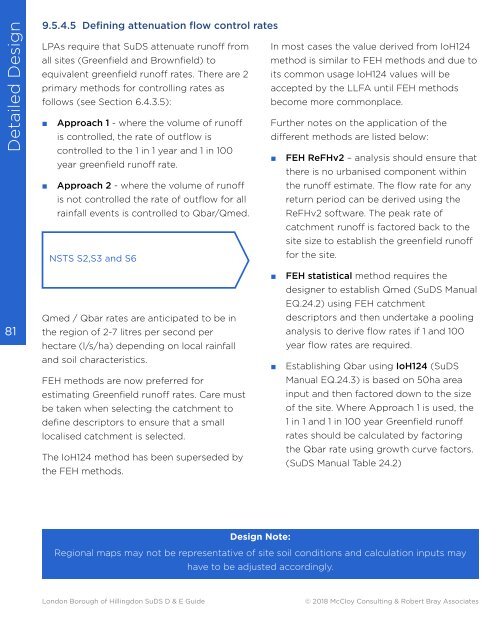Hillingdon SuDS Design & Evaluation Guide
Create successful ePaper yourself
Turn your PDF publications into a flip-book with our unique Google optimized e-Paper software.
Detailed <strong>Design</strong><br />
9.5.4.5 Defining attenuation flow control rates<br />
LPAs require that <strong>SuDS</strong> attenuate runoff from<br />
all sites (Greenfield and Brownfield) to<br />
equivalent greenfield runoff rates. There are 2<br />
primary methods for controlling rates as<br />
follows (see Section 6.4.3.5):<br />
■■<br />
■■<br />
Approach 1 - where the volume of runoff<br />
is controlled, the rate of outflow is<br />
controlled to the 1 in 1 year and 1 in 100<br />
year greenfield runoff rate.<br />
Approach 2 - where the volume of runoff<br />
is not controlled the rate of outflow for all<br />
rainfall events is controlled to Qbar/Qmed.<br />
NSTS S2,S3 and S6<br />
In most cases the value derived from IoH124<br />
method is similar to FEH methods and due to<br />
its common usage IoH124 values will be<br />
accepted by the LLFA until FEH methods<br />
become more commonplace.<br />
Further notes on the application of the<br />
different methods are listed below:<br />
■■<br />
FEH ReFHv2 – analysis should ensure that<br />
there is no urbanised component within<br />
the runoff estimate. The flow rate for any<br />
return period can be derived using the<br />
ReFHv2 software. The peak rate of<br />
catchment runoff is factored back to the<br />
site size to establish the greenfield runoff<br />
for the site.<br />
81<br />
Qmed / Qbar rates are anticipated to be in<br />
the region of 2-7 litres per second per<br />
hectare (l/s/ha) depending on local rainfall<br />
and soil characteristics.<br />
FEH methods are now preferred for<br />
estimating Greenfield runoff rates. Care must<br />
be taken when selecting the catchment to<br />
define descriptors to ensure that a small<br />
localised catchment is selected.<br />
The IoH124 method has been superseded by<br />
the FEH methods.<br />
■■<br />
■■<br />
FEH statistical method requires the<br />
designer to establish Qmed (<strong>SuDS</strong> Manual<br />
EQ.24.2) using FEH catchment<br />
descriptors and then undertake a pooling<br />
analysis to derive flow rates if 1 and 100<br />
year flow rates are required.<br />
Establishing Qbar using IoH124 (<strong>SuDS</strong><br />
Manual EQ.24.3) is based on 50ha area<br />
input and then factored down to the size<br />
of the site. Where Approach 1 is used, the<br />
1 in 1 and 1 in 100 year Greenfield runoff<br />
rates should be calculated by factoring<br />
the Qbar rate using growth curve factors.<br />
(<strong>SuDS</strong> Manual Table 24.2)<br />
<strong>Design</strong> Note:<br />
Regional maps may not be representative of site soil conditions and calculation inputs may<br />
have to be adjusted accordingly.<br />
London Borough of <strong>Hillingdon</strong> <strong>SuDS</strong> D & E <strong>Guide</strong><br />
© 2018 McCloy Consulting & Robert Bray Associates


